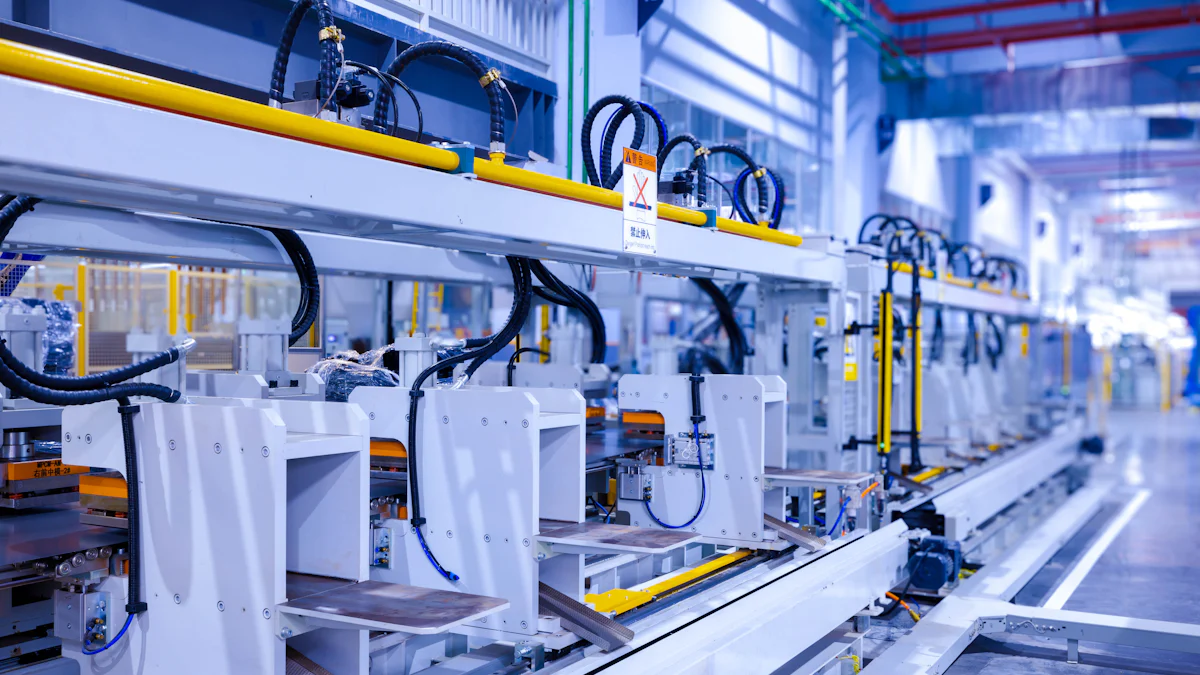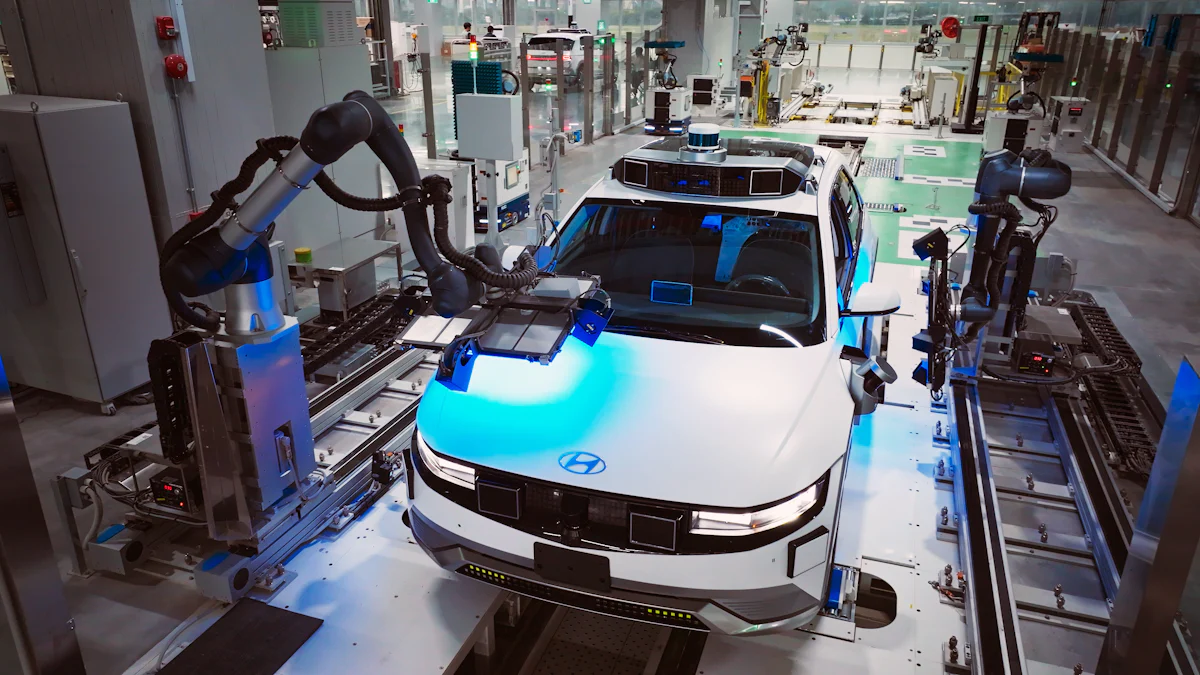Emerging Trends and Innovations in Manufacturing Supply Chains: A Comparative Analysis of Chinese and American Manufacturing

Manufacturing supply chains play a crucial role in the global economy. The focus on Chinese and American manufacturing sectors reveals significant insights. Emerging trends drive innovations that reshape these industries. The global supply chain management market reached approximately $23.5 billion in 2023. The figures highlight the dynamic nature of manufacturing supply chains. Understanding these trends is essential for staying competitive.
Overview of Manufacturing Supply Chains
Definition and Importance
Manufacturing supply chains encompass a network of processes involved in producing and delivering goods. These processes include sourcing raw materials, manufacturing products, and distributing them to consumers. Efficient supply chains ensure timely delivery and cost-effectiveness.
Key Components
Key components of manufacturing supply chains include suppliers, manufacturers, warehouses, distribution centers, and retailers. Suppliers provide raw materials. Manufacturers transform these materials into finished products. Warehouses store goods until needed. Distribution centers handle logistics. Retailers sell products to consumers.
Role in Global Economy
Manufacturing supply chains play a vital role in the global economy. They facilitate international trade and economic growth. Efficient supply chains reduce costs and improve product availability. They also enhance competitiveness by enabling companies to respond quickly to market demands.
Historical Context
The evolution of manufacturing supply chains reflects advancements in technology and logistics. Historical events have significantly influenced these changes.
Evolution Over Time
World War I and II innovations led to sophisticated methods for mobilizing, tracking, and transporting resources. These methods changed how goods were manufactured, stored, and transported. The 1950s saw containerization revolutionize shipping and logistics. Standardized containers improved efficiency and reduced time and costs. The 1980s introduced the term "supply chain management" alongside technological advancements like personal computing.
Major Milestones
World War II: Logistics became crucial for manufacturing military equipment and supplies. Efficient support for troops abroad was necessary.
1950s Containerization: Standardized containers transformed global shipping. This innovation streamlined logistics and reduced costs.
1980s Technological Advancements: Personal computing and other technologies enhanced supply chain management. These advancements improved efficiency and coordination.
Manufacturing supply chains have continually evolved, driven by technological innovations and historical events. Understanding this evolution helps in appreciating their current complexity and importance.
Emerging Trends in Manufacturing Supply Chains

Technological Advancements
Automation and Robotics
Automation and robotics have revolutionized manufacturing supply chains. Industrial robots now dominate factory floors due to their accuracy, precision, endurance, and speed. These robots streamline production processes, reducing labor costs and increasing efficiency. Leading manufacturers invest heavily in robotics to alleviate labor shortages and enhance productivity. The integration of robotics into manufacturing has reshaped the industry, making it more efficient and cost-effective.
Internet of Things (IoT)
The Internet of Things (IoT) has become a significant trend in manufacturing. IoT sensors enable machines to communicate, share data, and coordinate activities autonomously. This connectivity improves operational efficiency and reduces energy usage. IoT-equipped robots utilize data from connected sensors to optimize production processes and monitor equipment health. The combination of IoT technology with robotics has ushered in a new era of intelligence and efficiency in manufacturing.
Sustainability and Green Manufacturing
Eco-friendly Practices
Eco-friendly practices have gained prominence in manufacturing supply chains. Companies adopt sustainable methods to minimize environmental impact. These practices include using renewable energy sources, reducing waste, and recycling materials. Manufacturers also focus on designing products that are easier to recycle or dispose of responsibly. By implementing eco-friendly practices, companies not only protect the environment but also enhance their brand reputation.
Regulatory Compliance
Regulatory compliance plays a crucial role in green manufacturing. Governments worldwide impose regulations to ensure environmentally responsible practices. Manufacturers must adhere to these regulations to avoid penalties and maintain market access. Compliance involves meeting standards for emissions, waste management, and resource usage. Companies that prioritize regulatory compliance demonstrate their commitment to sustainability and gain a competitive edge.
Digital Transformation
Big Data and Analytics
Big data and analytics have transformed manufacturing supply chains. Companies collect vast amounts of data from various sources, including IoT sensors and production equipment. Advanced analytics tools process this data to provide insights into operational performance. These insights help manufacturers optimize processes, predict maintenance needs, and improve decision-making. Big data enables real-time monitoring and enhances supply chain visibility.
Blockchain Technology
Blockchain technology offers significant benefits for manufacturing supply chains. Blockchain provides a secure and transparent way to track products from production to delivery. This technology ensures data integrity and reduces the risk of fraud. Manufacturers use blockchain to verify the authenticity of products and trace their origins. By implementing blockchain, companies enhance trust and accountability within their supply chains.
Innovations in Chinese Manufacturing

Government Policies and Initiatives
Made in China 2025
The Chinese government launched the "Made in China 2025" initiative to transform China into a global manufacturing leader. This policy aims to upgrade China's manufacturing capabilities by focusing on high-tech industries. The initiative emphasizes innovation, quality, and efficiency. The government provides substantial funding and support to companies that align with this vision. This initiative has led to significant advancements in sectors such as robotics, aerospace, and new energy vehicles.
Belt and Road Initiative
The Belt and Road Initiative (BRI) is another key policy driving innovation in Chinese manufacturing. This ambitious project seeks to enhance global trade routes and infrastructure. The BRI connects Asia with Europe and Africa through a network of railways, ports, and highways. Chinese manufacturers benefit from improved logistics and expanded markets. The initiative also fosters international collaboration and investment. By participating in the BRI, Chinese companies gain access to new opportunities and resources.
Technological Innovations
Smart Factories
Smart factories represent a major technological innovation in Chinese manufacturing. These factories utilize advanced technologies such as artificial intelligence (AI), IoT, and big data. Smart factories optimize production processes through real-time monitoring and automation. AI algorithms analyze data to predict maintenance needs and improve efficiency. IoT sensors enable machines to communicate and coordinate activities autonomously. This integration of technology enhances productivity and reduces costs.
Advanced Manufacturing Techniques
Chinese manufacturers have adopted advanced manufacturing techniques to stay competitive. Techniques such as additive manufacturing (3D printing) and precision machining are widely used. Additive manufacturing allows for rapid prototyping and customization. Precision machining ensures high-quality and consistent production. These techniques reduce waste and improve product quality. Chinese companies invest heavily in research and development to stay at the forefront of these innovations.
Innovations in American Manufacturing
Government Policies and Initiatives
Manufacturing USA
The U.S. government launched Manufacturing USA to revitalize the manufacturing sector. This initiative aims to foster innovation through public-private partnerships. Manufacturing USA focuses on advanced manufacturing technologies. The program supports research and development in key areas. These areas include additive manufacturing, robotics, and digital manufacturing.
Manufacturing USA consists of 14 institutes. Each institute specializes in a specific technology area. These institutes collaborate with industry, academia, and government agencies. The goal is to accelerate the commercialization of new technologies. By fostering innovation, Manufacturing USA enhances the competitiveness of American manufacturing.
Trade Policies
Trade policies play a crucial role in shaping American manufacturing. The U.S. government implements policies to protect domestic industries. Tariffs on imported goods help level the playing field for American manufacturers. Trade agreements also open new markets for American products. These agreements reduce barriers to trade and promote exports.
The U.S.-Mexico-Canada Agreement (USMCA) replaced NAFTA. USMCA includes provisions to support American manufacturing. The agreement sets higher labor standards and rules of origin. These provisions ensure that more manufacturing takes place within North America. By promoting fair trade, these policies strengthen the American manufacturing sector.
Technological Innovations
Additive Manufacturing
Additive manufacturing, also known as 3D printing, revolutionizes production processes. This technology builds objects layer by layer from digital models. Additive manufacturing allows for rapid prototyping and customization. Manufacturers can produce complex shapes that are difficult with traditional methods.
Additive manufacturing reduces material waste. Only the necessary material is used to create the object. This efficiency lowers production costs and environmental impact. Leading companies invest in additive manufacturing to stay competitive. This technology enables faster product development and innovation.
Cyber-Physical Systems
Cyber-physical systems (CPS) integrate physical processes with digital technologies. These systems use sensors, software, and networks to monitor and control physical operations. CPS enhances manufacturing by providing real-time data and automation. This integration improves efficiency, quality, and safety.
Manufacturers use CPS to optimize production processes. Sensors collect data on machine performance and product quality. Software analyzes this data to identify issues and suggest improvements. Networks enable communication between machines and systems. This connectivity allows for coordinated and efficient operations.
Comparative Analysis
Strengths and Weaknesses
Technological Capabilities
China excels in deploying robotic systems across manufacturing sectors. This widespread adoption enhances efficiency and reduces labor costs. Chinese factories account for 28% of the world's total, showcasing the country's massive production capacity. Lower labor costs further strengthen China's competitive edge.
American manufacturing stands out for innovation and technological prowess. U.S. companies invest heavily in research and development. This investment drives advancements in automation, additive manufacturing, and cyber-physical systems. The focus on high-tech solutions positions the U.S. as a leader in cutting-edge manufacturing technologies.
Policy Support
China's government policies significantly bolster its manufacturing sector. Initiatives like "Made in China 2025" and the Belt and Road Initiative provide substantial funding and strategic direction. These policies aim to transform China into a global manufacturing leader. Government support accelerates technological adoption and infrastructure development.
The U.S. government also plays a crucial role in supporting manufacturing. Programs like Manufacturing USA foster innovation through public-private partnerships. Trade policies, including tariffs and agreements like the USMCA, protect domestic industries and promote exports. These measures ensure a competitive environment for American manufacturers.
Opportunities and Challenges
Market Dynamics
China benefits from lower labor costs and a vast manufacturing base. These factors attract global companies seeking cost-effective production solutions. However, higher shipping costs and tariffs on Chinese goods pose challenges. Companies must navigate these obstacles to maintain competitiveness.
The U.S. market dynamics favor bigger companies and larger orders. American manufacturers often focus on high-value products and advanced technologies. This approach drives innovation but may limit flexibility in responding to smaller-scale demands. Balancing innovation with market responsiveness remains a key challenge.
Global Competition
China's manufacturing sector faces intense global competition. Intellectual property theft costs the U.S. between $225 billion and $600 billion annually. This issue strains international relations and impacts China's reputation. Addressing IP concerns is crucial for sustaining global partnerships.
American manufacturers compete on innovation and quality. The U.S. leads in developing advanced manufacturing techniques and digital technologies. However, higher labor costs and regulatory complexities present challenges. Maintaining a competitive edge requires continuous investment in technology and workforce development.
Future Outlook
Predicted Trends
Continued Digitalization
Manufacturers will continue to embrace digital transformation. The integration of advanced technologies will drive efficiency and innovation. According to a McKinsey report, digitization and automation have reduced deviations in manufacturing by over 65 percent. This reduction helps avoid product recalls and improves customer satisfaction. Digital supply chain tools will enhance visibility and control. Companies will rely on data-driven processes to make informed decisions. Investments in digital capabilities will widen the competitive gap between forward-thinking manufacturers and those lagging behind.
Focus on Sustainability
Sustainability will become a central focus in manufacturing. Eco-friendly practices will gain prominence. Companies will adopt renewable energy sources and reduce waste. Regulatory compliance will ensure environmentally responsible operations. Manufacturers will design products for easier recycling and disposal. Sustainable practices will enhance brand reputation and customer loyalty. The push for green manufacturing will align with global environmental goals. Companies will invest in technologies that minimize their carbon footprint.
The blog discussed key points about the evolving trends and innovations in manufacturing supply chains in China and the USA. Staying ahead in manufacturing supply chains is crucial for maintaining competitiveness. The future of manufacturing will see a shift towards smart factories, advanced technologies, and local automated production. Embracing these changes will ensure that Chinese and American manufacturers remain leaders in the global market.
See Also
Efficient Strategies for Supply Chain Challenges in High-Tech Manufacturing
Investigating Robotic Tech: Revolutionizing the Supply Chain
Guiding Lean Logistics to Achieve High-Tech Manufacturing Success
Delving into Sustainable Robotics Trends in Supply Chain Management
Maximizing Efficiency with AI Innovations in the Supply Chain
